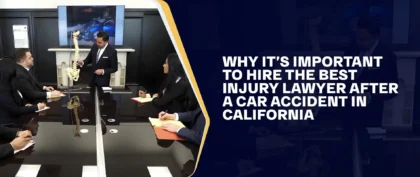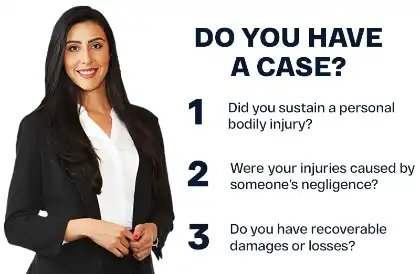Table of Contents
A car accident has the potential to cause different kinds of damage, including some common physical injuries. These may cause serious temporary or permanent bodily harm to drivers, passengers, or even innocent bystanders.
The National Highway Traffic Safety Administration (NHTSA) reported that an estimated 2.74 million people suffered injuries in motor vehicle accidents in 2019. Their type and severity can vary depending on several factors, although certain injuries are more common than others.
Nearly 42,000 crashes in 2020 proved to be fatal accidents, while 4.8 million collisions resulted in people suffering injuries. Car accidents involve an estimated economic cost of approximately $871 billion each year, which is about $900 for every person residing in the United States.
People who suffer minor injuries in accidents can often recover on their own without medical treatment. However, those with more severe injuries may require several rounds of care. Some people may be dealing with extensive treatment.
Several factors can play a role in the nature of injuries people suffer, such as whether drivers or passengers are wearing seat belts, where the crash impact occurred, which way vehicle occupants were facing at the time of a collision, whether a car was traveling at a low or high speed at the time of a crash, and the prevalence and deployment of airbags.
Most injuries will be classified as either impact or penetrating injuries. The impact injury typically involves a part of a person’s body making contact with some other object, such as a person’s head striking a dashboard or window. Penetrating injuries usually involve some tearing of the skin, such as lacerations from shattered glass.
Even though the injuries people can suffer vary depending on multiple factors, certain types of injuries are more common than others. Many people find it helpful to consult with legal counsel to understand their options for seeking compensation after a car accident.
If these injuries were caused by another’s negligence, car accident cases could result in settlements paid to people injured in automobile accidents. Some cases may go to trial and lead to victims being given jury awards. Compensatory damages are intended to restore a person to their original condition or as close thereto and aim to help an individual manage the consequences of an accident.
Some of the most common kinds of injuries people suffer in car accidents include the following:
Soft Tissue Injuries
Soft tissue injuries are usually divided into two groups. Acute soft tissue injuries result from sudden trauma, while overused soft tissue injuries involve repeated stress on an area of the body.
Common kinds of soft tissue injuries include:
- Whiplash — a neck strain injury that involves muscle or tendon damage.
- Contusions — a bruise in which underlying fibers and tissue are crushed, resulting in symptoms like pain, swelling, and discoloration.
- Sprains — partial tears to ligaments.
- Tendonitis — inflammation of the tendon, or the tissue connecting the bone to the muscle, usually as a result of repetitive motion or overuse.
- Bursitis — inflammation of the bursa, or the sac providing a cushion between the bones and the muscles.
- Stress Fractures — small cracks in a bone, usually a weight-bearing bone in the lower extremities.
- Strains — strained or pulled muscles.
- Tenosynovitis — inflammation of the tendon sheath where the muscle connects to the bone.
Repetitive strain injuries, such as carpal tunnel syndrome, are also considered soft tissue injuries. Proving soft tissue injuries can be more challenging, but not impossible. Car accident lawyers can work with medical professionals to document these injuries and show how they relate to a collision.
Scrapes & Cuts
Scrapes and cuts are actually two different concepts because scrapes are also known as abrasions and wounds in which layers of skin are scraped or torn. Meanwhile, cuts are defined as long, narrow incisions in the skin. People may suffer scrapes or cuts when a car accident causes the glass to shatter or even when they strike certain types of sharp objects.
Many scrape and cut cases involve minor injuries that do not require further medical treatment, but some injuries can require stitches. Airbags may also cause cuts or scrapes upon deployment in a collision.
When a scrape or cut is infected, seek medical attention. Some signs to look for include any pain or swelling within 48 hours of a crash, a scab getting bigger, redness around a wound that has gotten worse, pus, or a fever.
Head Injuries
When a person strikes their head against anything within a motor vehicle in a car accident, it has the potential to be a serious injury. There are different kinds of head injuries that can cause underlying complications.
Closed head injuries are a kind of trauma to the head that does not cause a break in the skull. The brain and soft tissue can still suffer damage, leading to bleeding and swelling inside the head.
Mild closed head injuries can involve treatment requiring mental and physical rest, but a moderate or severe closed head injury can require emergency care, including supportive care, such as oxygen, IV fluids, and nutrition therapy.
A concussion is a mild traumatic brain injury (TBI) that rarely involves a loss of consciousness. No single universal classification or grading system exists for concussions. Still, several grading systems exist, and the three most widely followed include the grading systems of Robert Cantu, Clinical Professor of Neurology and Neurosurgery and Co-Founder of the CTE Center at the Boston University School of Medicine, the Colorado Medical Society, and the American Academy of Neurology.
All three systems divide concussions into three grades. Under the Cantu system, a Grade I concussion involves no loss of consciousness and less than 30 minutes of post-traumatic amnesia; a Grade II concussion involves loss of consciousness for less than five minutes or amnesia lasting 30 minutes to 24 hours; and a Grade III concussion involves loss of consciousness for more than five minutes or amnesia for more than 24 hours.
Under the Colorado Medical Society system, a Grade I concussion involves no loss of consciousness and confusion; a Grade II concussion involves no loss of consciousness, confusion, and post-traumatic amnesia; and a Grade III concussion involves any loss of consciousness. Under the American Academy of Neurology system, a Grade I concussion involves no loss of consciousness, confusion, and less than 15 minutes of symptoms; a Grade II concussion involves no loss of consciousness and symptoms last for longer than 15 minutes; and a Grade III concussion involves loss of consciousness, with Grade IIIa being a coma that lasts seconds and Grade IIIb being a coma that lasts minutes.
A TBI is a brain injury stemming from a sudden trauma, causing damage to the brain. TBI symptoms may be either mild, moderate, or severe.
In cases of severe TBI, patients may require surgery to remove or repair hematomas (ruptured blood vessels) or contusions (bruised brain tissue). TBI victims can suffer from problems with cognition (thinking, memory, and reasoning), sensory processing (sight, hearing, touch, taste, and smell), communication (expression and understanding), and behavior or mental health (depression, anxiety, personality changes, aggression, acting out, and social inappropriateness).
Certain cases can also involve an intracranial hematoma, which refers to the presence of several types of blood clots in or around the brain.
Herniated Discs
A herniated or bulging disk can occur after a car accident damages one of the rubbery cushions between the spinal vertebrae. A herniated disk can cause numbness, tingling, and pain that goes down the back and legs, worsening with movement and activity.
Herniated disk victims can struggle to deal with many daily tasks, especially ones involving lifting, bending, or long periods of activity. Herniated disk pain often runs into the arms and legs and may lead to weakness in a limb.
Depending on the extent of a herniated disk injury and its impact on a victim’s life, necessary treatment may require physical therapy, chronic pain management, and surgery. According to the Mayo Clinic, a physical exam and a medical history will be all that is required for a diagnosis in most herniated disk cases.
If a doctor suspects another condition or needs to see how nerves are being affected, there can be orders for more tests. These can include imaging tests such as X-rays, which do not detect herniated disks but can rule out other possible causes of back pain such as infections, tumors, or broken bones; computed tomography (CT) scans, which take a series of X-rays from different directions, and combines them to create cross-sectional images of a spinal column and the structures around it; magnetic resonance imaging (MRI) in which waves and a strong magnetic field create images of the body’s internal structures and confirm the location of a herniated disk to see the nerves that are affected; and myelograms involving injection of dye into spinal fluid before taking a CT scan to show pressure on a spinal cord or nerves.
Nerve tests such as electromyograms and nerve conduction studies measure how well electrical impulses are moving along nerve tissue and pinpoint the location of nerve damage. A nerve conduction study measures electrical nerve impulses and functioning in the muscles and nerves through electrodes placed on the skin. Electromyography (EMG) involves a doctor inserting a needle electrode through the skin into various muscles to evaluate the electrical activity of muscles when contracted and at rest.
Medications may involve nonprescription pain medications such as acetaminophen (Tylenol, others), ibuprofen (Advil, Motrin IB, others) or naproxen sodium (Aleve), neuropathic drugs such as gabapentin (Gralise, Horizant, Neurontin), pregabalin (Lyrica), duloxetine (Cymbalta, Drizalma Sprinkle), or venlafaxine (Effexor XR), muscle relaxers, opioids such as codeine or an oxycodone-acetaminophen combination (Percocet, Oxycet), and cortisone injections.
Therapy and surgery can also be necessary in some cases.
Chest Injuries
Chest injuries can be especially common in car accidents, often ranging from painful bruises to broken ribs or other internal organ injuries. A common cause of chest injuries can be collisions between drivers and steering wheels, and many chest injuries in car accidents are contusions or bruises, although other, more severe injuries can also be possible.
Severe chest injuries often include broken ribs and injuries to internal organs that are not always immediately identifiable to most people. Seatbelts and dashboards can also be other common causes of chest injuries for other occupants.
Seek medical attention after a car accident if you experience chest injury symptoms such as shortness of breath, bruising or swelling, numbness or tingling, redness, rapid changes to a person’s heart rate, coughing, shallow or fast breathing, a crackling sound in the chest, low blood pressure, or coughing up blood.
Arm & Leg Injuries
The arms and legs of many motor vehicle occupants can be more vulnerable to injury. In many cases, people may deal with broken bones.
When a car accident results in a broken arm or leg, a person will often have to wear a cast and presumably be unable to work again for several weeks. Look for symptoms such as pain, bruising, swelling, numbness, tingling, a limited range of motion, a snapping or popping sound, and deformity.
Spinal Cord Injuries & Paralysis (Quadriplegia, Tetraplegia, And Paraplegia)
Spinal cord injuries involve damage to the bundle of cells and nerves that send and receive certain signals from the brain to and from the rest of the body. Spinal cord injuries can result from direct injuries to the spinal cord itself or damage to the tissue and bones (vertebrae) surrounding the spinal cord.
Damage can result in temporary or permanent changes in sensation, movement, strength, and body functions below the site of an injury. Incomplete spinal cord injuries refer to spinal cords that are still able to transmit messages to and from the brain to the rest of the body. Complete spinal cord injuries involve no nerve communication and motor function (voluntary movement) below the affected area.
Back Injuries
Back injuries can include sprains and strains, fractured vertebrae, thoracic spine injuries in the mid-back, chest, and rib area, herniated or bulging discs, lumbar spine or lower back injuries, cervical fractures, herniated discs, cervical dislocation, spondylolisthesis, muscle tension, cervical radiculopathy, and spinal stenosis. Back injuries can also lead to an increased risk of musculoskeletal disorders affecting the movement of the entire body’s musculoskeletal system.
Watch for such symptoms as pain, tenderness, stiffness, muscle spasms, numbness, tingling, paralysis, and an inability to maintain normal posture.
Burn Injuries
Serious burn injuries can require first aid and wound assessment, with treatment involving medications, wound dressings, therapy, and surgery. Some victims may also require treatment at dedicated burn centers for skin grafts to cover large wounds.
Medical care can also include medications and products such as water-based treatments to clean and stimulate the wound tissue, intravenous (IV) fluids to prevent dehydration, pain and anxiety medications such as morphine, burn creams and ointments such as bacitracin and silver sulfadiazine (Silvadene) for wound healing, specialty wound dressings to prepare a wound to heal, drugs intended to fight infection, and tetanus shots.
Internal Organ Injuries
An internal organ injury can be dangerous because failure to treat it could cause serious complications or even death. However, its presence may not be immediately apparent after a crash. Some internal injuries can include brain bleeds, broken ribs, pneumothorax involving a rib puncturing a lung, abdominal aorta aneurysms involving the stomach being compressed during an accident and causing a rupture of the abdominal aorta, ruptured spleens, internal bleeding, or other internal organ injuries.
Fractures
Some fractures do not need much time to heal, but other types may require surgery or cause long-term disabilities. Serious fractures might need reconstructive surgery and possibly the insertion of pins, plates, and screws, also requiring longer hospital stays, rehabilitation, and sometimes additional surgery.
Disfiguring Facial Injuries & Scars
An unfortunate consequence of some accidents can be injuries to people’s faces that leave them permanently deformed. Such injuries may be the result of broken glass or impact with other objects, and surgical corrections may be possible in some cases.
Limb Loss & Amputation
Some people can experience injuries to their arms, legs, fingers, or toes that require surgical amputation. The loss of a limb could potentially have a profound impact on a person’s life.
Neck Injuries & Whiplash
Whiplash is again a common kind of soft tissue and neck injury claim in many cases handled by our car accident lawyers, but other neck injuries in car accidents can include cervical spondylolisthesis, slipped or herniated discs, neck sprains or strains, pinched nerves, stiff muscles and tendons, facet joint injuries, neck fractures or compressions, and muscle spasms.
Knee Injuries
A person’s knee can be hurt because it hits another object due to the impact of a collision. The meniscus or cartilage in the knee may also tear if the joint twists or turns abruptly in a crash.
Foot & Ankle Injuries
Many people might not immediately fear for their feet in car accidents, but there can be cases in which it is actually a person’s toes, feet, or ankles that suffer injuries.
Shoulder Injuries
A shoulder injury can be a fracture, deep tissue bruising, a strain or sprain, or a rotator cuff tear. Shoulder injuries can also be more difficult to diagnose, as symptoms may not appear for several days.
Wrist & Hand Injuries
People, in some cases, may have their hands, fingers, or wrists injured in certain accidents. Some hand injuries may require people to undergo surgery.
Crush Injuries
A crush injury is a type of harm that occurs in a car wreck when a person’s entire body or a part of their body ends up caught between two components and crushed. Such injuries have the potential to be fatal, but even nonfatal injuries have the potential to cause permanent disabilities and complications.
Crush injuries can cause significant bodily harm, including damage to tissues that disrupt blood flow and infections. Additional complications may include compartment syndrome, which is a painful condition occurring when pressure within the muscles builds to dangerous levels and decreases blood flow, preventing nourishment and oxygen from reaching nerve and muscle cells.
Compartment syndrome is generally either acute, meaning it has severe symptoms for a short period of time, or chronic, which involves longer-lasting symptoms. Acute compartment syndrome is still a medical emergency, and a lack of treatment can lead to permanent muscle damage.
Chronic compartment syndrome may not always be a medical emergency because it can be reversible with rest. Similarly, crush syndrome or rhabdomyolysis involves a series of metabolic changes because of injuries to the skeletal muscles of such severity as to cause a disruption of cellular integrity and release contents into the circulation.
Post-Traumatic Stress Disorder (PTSD)
PTSD can be the result of traumatic events during motor vehicle accidents. Common symptoms of PTSD include, but are not limited to:
- Flashbacks — People re-experience traumatic events during nightmares or bouts of insomnia.
- Arousal — Some victims may be more irritable or angered due to a feeling of constantly being on edge, often involving difficulty sleeping.
- Avoidance — Victims may try to distance themselves from people, places, or activities that remind them of traumatic events.
- Depression — Many victims will battle feelings of guilt, helplessness, and confusion about their condition.
Avoiding Common Injuries Resulting From Car Accidents
People cannot control the actions of other drivers, but they can learn how to potentially avoid or minimize the injuries they may suffer if an accident occurs. The first thing all motor vehicle occupants should do is fasten their seat belts. Wearing a seat belt has been conclusively proven to reduce the likelihood of serious injuries in accidents.
It is also important for all drivers to obey posted speed limits, not just to avoid possible traffic tickets but also to reduce the chances of causing a collision. Finally, people need to adequately maintain their motor vehicles and make sure their cars are getting the necessary service to function properly.
What To Do At The Scene Of An Accident
When a person is injured in a car accident, they should check themselves for injuries and then immediately call 911 to report the crash. Every person should make an effort to receive medical attention as soon as possible, even when they do not think they have suffered an injury.
Have a doctor perform a complete evaluation to ensure that you did not suffer an injury that involves delayed symptoms. It is important to get a medical record created as soon as possible because most insurance companies will require proof of medical care before they agree to pay any damages.
While waiting for the police to arrive, people should try to take photographs or videos of the entire crash scene. Make sure to focus on certain areas of note, such as skid marks. Try to get images from multiple angles and distances.
You can see if there were any witnesses to your accident and ask them for their contact information.
How Soon To See A Doctor
People should always seek medical attention after any car accident, even a minor collision. It is essential to get proper treatment, regardless of the severity of the injury, so a person can take the appropriate steps to care for themselves.
You might also not want to delay visiting a hospital because waiting too long to get medical care could seriously complicate your injury claim later on. If you wait several days or weeks to obtain treatment, you could run into arguments that your injuries were not connected to the car crash and thus are not compensable.
How Long Does It Take For Injuries To Appear?
The one major concern in most car accident cases is that people will not realize they suffered an injury because symptoms may not begin for several days or even weeks. Delayed symptoms are especially common with head injuries, back injuries, and internal organ injuries.
People need to appreciate the effect that adrenaline can have on their common injuries resulting from car accidents because adrenaline triggers the body’s fight-or-flight response, so a person may not immediately realize they are hurt. The bottom line is that it is always critical to get a medical professional to review a person’s condition as soon as possible after a car accident.
What Happens In Car Accidents Without Injuries?
Certain car accidents can involve nobody suffering any injury and no damage to any vehicle. Such cases are rare but do happen, and the drivers may agree to avoid any insurance claims.
There can also be car accidents that do not result in injuries to people but still involve considerable property damage to the cars involved. In such cases, it will usually be the negligent driver’s insurance company that assumes the costs of repair or replacement. Lawyers for car accident cases may still review these incidents to clarify liability and document property damage. They can also help you check whether all reporting and insurance requirements are properly followed.
Legal Help For California Car Accident Injury Victims
Though you can technically handle a car accident claim yourself, doing so could be challenging if you’re not familiar with the claims process. In this scenario, you can always consider seeking legal guidance. Consulting with an attorney can help you understand how you can pursue compensation for common car accident injuries.
If you choose to have a personal injury attorney assist with your car accident case, they can study the extent of your injuries and could help you access appropriate treatment options. An experienced car accident attorney can also work to calculate the potential value of your damages and may present other legal options available for your case.
Arash Law can examine available evidence and collect information regarding common injuries resulting from car accidents that may support your case. Our accident lawyers can also collaborate with hospitals and medical care providers to arrange medical liens, which essentially allows our clients to pay for treatment out of any potential settlement they’re awarded. This arrangement aims to help them manage medical costs while pursuing compensation.
Consult Arash Law’s California Car Accident Attorneys
People who suffer common injuries resulting from car accidents may wish to learn more about their rights and what they can do to pursue compensation for the losses they incur after a crash. The team of car accident lawyers at Arash Law understands the challenges people usually face in these situations. We can step in to manage the claims process, allowing you to focus on your well-being.
Our car accident lawyers can help you seek compensation for losses caused by common injuries resulting from car accidents, including medical bills, lost wages, or pain and suffering. Our lawyers for car accident cases can help handle negotiations for settlements on your behalf.
Arash Law operates on a contingency fee basis, meaning attorney fees are only collected if compensation is awarded to one of our clients. However, they may still be responsible for court costs or other case-related expenses, regardless of the outcome of their claim. You can call our accident lawyers at (888) 488-1391 or contact us online to schedule a free initial consultation about your case.































